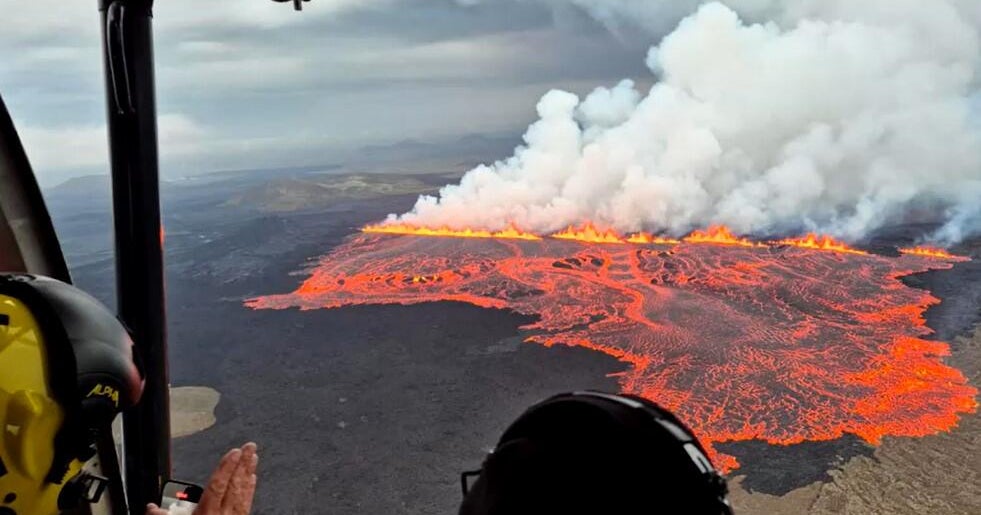A volcanic eruption in southwestern Iceland has triggered the evacuation of tourists from the renowned Blue Lagoon geothermal spa, as reported by national broadcaster RUV. The eruption commenced approximately at 4 a.m. following a notable seismic surge on the Reykjanes Peninsula, near Reykjavik. Authorities have mobilized evacuation efforts to ensure the safety of residents and visitors alike, although it has been stipulated that no immediate infrastructure is at risk from the flowing lava.
| Article Subheadings |
|---|
| 1) Overview of the Eruption |
| 2) Response and Evacuation Efforts |
| 3) Historical Context of Volcanic Activity |
| 4) Implications for Tourists and Locals |
| 5) Geographical Significance of Iceland |
Overview of the Eruption
The recent volcanic eruption in Iceland began early in the morning at approximately 4 a.m. local time, as confirmed by the Icelandic Meteorological Office. Seismic activity that preceded the eruption has been noted as particularly intense, indicating a buildup of pressure beneath the Earth’s surface on the Reykjanes Peninsula, located in the southwestern region of the country. This eruption is a continuation of volcanic activity observed in the area since November 2023 when a previously dormant volcano reactivated after lying inactive for nearly 800 years. The fissure that opened during the eruption ranges from about 2,300 to 3,300 feet wide, expelling lava southeastwards across the barren landscape.
Response and Evacuation Efforts
In the wake of the eruption, immediate evacuation measures have been implemented to safeguard tourists and residents in Grindavik, a town closely located to the eruption site. The Blue Lagoon, a significant tourist attraction known for its natural geothermal waters, found itself in the midst of the crisis, requiring guests to vacate swiftly. Visitors were rushed to collect their belongings and leave the premises as authorities activated emergency protocols. A nearby campsite also faced evacuation due to safety concerns regarding the volcanic activity. Fortunately, the flow of lava has thus far posed no threats to infrastructure.
Historical Context of Volcanic Activity
The Reykjanes Peninsula has been no stranger to volcanic eruptions, echoing back to several events over the past years. Since the reactivation of the volcano in November 2023, a series of at least seven volcanic eruptions have occurred throughout 2024, leading to significant changes in the landscape and local livelihoods. These eruptions are particularly concerning as they disrupt the routine of daily life for residents of towns such as Grindavik. A notable eruption in April caused a similar evacuation of tourists from the Blue Lagoon, aligning with the current circumstances. Despite these disruptions, officials have reassured that residents remain safe, emphasizing that the town itself is not in immediate danger.
Implications for Tourists and Locals
The reoccurrence of volcanic eruptions raises concerns not only for immediate safety but also for the long-term impact on tourism and local economies heavily reliant on visitors. Iconic landmarks like the Blue Lagoon have faced repeated interruptions, which may dissuade tourists from visiting during peak periods. Additionally, local businesses that thrive on tourism may experience financial strain due to these disruptions. Authorities have emphasized their commitment to safety and recovery for the community, aiding in the coordination of evacuation efforts and information dissemination to affected populations. As authorities monitor the situation closely, they aim to restore normalcy as swiftly as possible amidst this geological unrest.
Geographical Significance of Iceland
Iceland occupies a unique geographical position atop a rift between the North American and Eurasian tectonic plates, rendering it one of the most volcanically active regions in the world. Comprised of over 30 active volcanic systems, the island is a hotspot for both geological research and tourist excursions. This geographical phenomenon not only underlines the beauty and natural allure of the country but also serves as a reminder of the constant geological processes occurring beneath the surface. As seismic activity continues to shape the landscape, the awareness of such natural occurrences becomes crucial for the inhabitants and visitors alike, urging them to remain vigilant while appreciating the stark beauty that these volcanic features impart on the Icelandic terrain.
| No. | Key Points |
|---|---|
| 1 | Recent volcanic eruption in southwestern Iceland prompted evacuations, particularly at Blue Lagoon. |
| 2 | Intense seismic activity led to the eruption, indicating a buildup of geological pressure. |
| 3 | Evacuation measures are in place to ensure safety for tourists and local residents in Grindavik. |
| 4 | Iceland’s geological nature makes it one of the most volcanically active places in the world. |
| 5 | Continuous volcanic activity poses challenges to local tourism and businesses. |
Summary
The recent volcanic eruption in Iceland serves as a stark reminder of the ongoing geological processes that shape the nation. While authorities act quickly to ensure the safety of both tourists and residents, the implications of such eruptions on local economies and livelihoods underscore the delicate balance between appreciating Iceland’s natural wonders and grappling with the hazards they pose. The community’s resilience and response to these challenges will inform how they navigate future uncertainties in this volcanically rich region.
Frequently Asked Questions
Question: What caused the recent volcanic eruption in Iceland?
The eruption was caused by intense seismic activity in the Reykjanes Peninsula, indicating a buildup of geological pressure underneath the Earth’s surface.
Question: What measures are being taken to ensure safety during volcanic eruptions?
Authorities are implementing immediate evacuation protocols to safeguard residents and tourists in proximity to volcanic activity, particularly in areas like Grindavik.
Question: How does Iceland’s geography contribute to its volcanic activity?
Iceland is located atop a rift between the North American and Eurasian tectonic plates, which makes it one of the most volcanically active regions globally.


